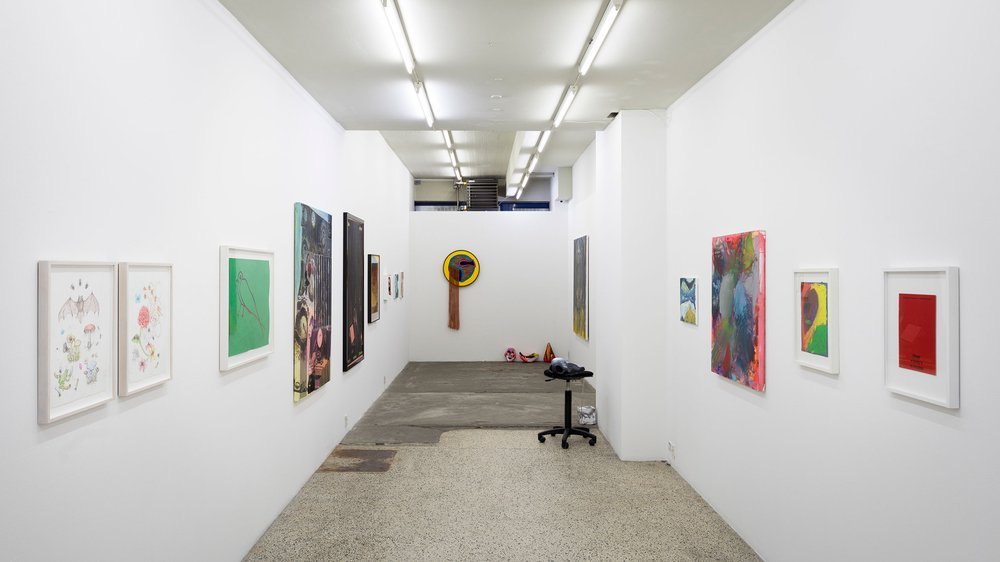Amalie Jakobsen’s ‘Wrongdoers” at Gether Contemporary
*Archive Article: Originally published in the magazine Blacklisted Copenhagen on March 30, 2017
Obtaining an understanding of the space between objects—if other words, the relationship between positive and negative space—is a fundamental building block for artists, designers, architects, interior designers, etc. Yet, while these fundamentals are often the basis for good aesthetics between exterior objects outside of our own bodies, rarely do we include our own physical form into the equation. Spatial awareness is reserved for navigation throughout the physical world, not for contemplating whether or not our presence affects the Feng Shui of a room. How many times have you walked into a room and asked yourself how the introduction of your presence has changed the aesthetic? How many times have looked upon artwork and pondered on how your gaze alters it.
Outside of the genre of stage arts and performance, It is rare altogether for us to include organic beings in the discussion of spatial representation unless those organic bodies are explicitly being used aesthetically. It is almost as if we are predisposed to think of inorganic and organic matter as whole separate things in relation to space, with “human” matter being the pinnacle silent observer of everything. In other words, we often fall into the thinking that the world exists solely for us to gaze upon, and our own physical bodies are irrelevant to the aesthetics of space.
What struck me as interesting about the sculptural and performative artwork of Danish artist Amalie Jakobsen is her explicit exploitation of our natural human tendency to remove ourselves from the spaces that we enter. It is not in our nature to walk into a gallery space and start to contemplate our own bodies affect the space and the artworks, and Jakobsen is very aware of this fact. Her work is based on research studying how spaces and color affect us, and she crafts her work specifically to exploit that.
We often forget our own bodies until an overwhelming emotional or physical sense reminds us of our relationship to the corporeal—be that through elation, uncomfort, pain, etc. Jakobsen’s sculptural work is crafted in a way to interrupt our natural laziness of drifting through a physical space.
For her upcoming exhibition at Gether Contemporary, I reached out to Amalie to get a better understanding of her forthcoming series of works entitled, Wrongdoers, which focused on sculptural iconography and how these symbols affect us.
Can you tell me a little about your background as an artist? When it was that you made the choice to live the (often) financially unstable life of an artist?
The need to make things and experiment is one of my first memories as a kid. As a teenager I painted, made installations, and designed cloth and bags, and growing up in Grenå (a tiny city in Denmark) I was bullied in school for being different, making odd things, and having ideas. So as soon as I had the chance and turned 18 I moved to London. To me, London represented a multicultural metropolitan and freedom of expression and where I became friends and worked for other artists. At this point in my life, I couldn’t imagine that art could be my life. I had a short detour where I studied art history for one year in Copenhagen before I decided to study art at Goldsmith University of London and move back to London. Goldsmiths was an amazing education with highly critical thinking and nearly no structure, so my peers and I constantly made shows and parties. Yes, art is a very financially unstable life and probably the economy that’s is closet to drug dealing. But to me it is an important way of existing in society: Having time to reflect and do mad installations to see the world from an odd angle.
Can you tell me a little bit about your background in sculptural and performative works?
My fascination with performance grew out from the experiences of global movements: airports and supermarkets. My fascination and fear of the manipulation of the mass. The situation where we are programmed to act in a certain way. As an example, the distance of a door of 80 cm will always produce transit. And the distance of 160 as in an airport queue you feel comfortable standing and waiting for more than 15 minutes without it feeling claustrophobic. I started to experiment with these proportions in my installations through purely forms and color.
My installations are spaces made for the human body, to articulate the given space and placement of color in space. It interests me to see what happens when such a color is introduced in a certain way; How is the room articulated? How are patterns of movement defined or altered? In what ways are the connections between those present shaped, enabled, or prevented? Such questions inevitably have political, social, and economic dimensions as it forms how we act in society. Space is for me more than volume, it is a complex of materials, multi-leveled realities and patterns, surfaces, bodies, forces and potential interactions to be experienced, examined, and reflected upon.
How did you develop your particular style?
This is just what I do and this style, language, or expression has developed throughout my life. I remember the way I designed clothes as a teenager was through an obsession with the cloth existing in space and having movement, transparency, and light. Those interests I still pursue now. I am interested in visual and spatial communication: signs and machines. All the mechanisms behind how we read a red triangle compared to a blue one. And in order to understand the complexity of that symbol lies an understanding of how the word red was invented, street signs, infrastructure, cultural differences and global consciousness. So to me working with abstract art and developing my particular style comes through an awareness of how abstraction is used in society, experimentation, fascination for color, form, and composition.
Can you tell me a little bit about your process about how to start a piece?
I can make a piece anytime… there is no beginning or end. It is like a continuous machine, which then needs to be fed with information, experiences, and visual stimulations in order to function.
The process for making an installation is a planned and engineered process. It takes a lot of technical production and first during installation I see the work for the first time. Whereas making sculptures is extremely quick. I never sketch beforehand, I work directly with the steel or aluminum and painting, which gives a lot of freedom and allows for new sculptures to appear.
Your works often dominate or transform the gallery space—do you develop your works specifically for the Gallery space?
Yes, the context of my work is within art and it is indifferent if it is a gallery space, warehouse, or my studio.
You sometimes use performance in your work, as in ‘Recursive Demarcation’ and ‘Untitled 2016’. Can you tell me how your process relates to performative work?
Recursive Demarcation is a performative installation that examines vision, power structures in public space, and means of occupation. The two mediums—sculpture and performance—offer different approaches to these ideas: The geometric sculpture employs flexible, soft industrial materials, suspended to create a linear drawing in space as temporary architecture. Whereas the performers, clad in hard aluminum costumes designed after the opening sequence of the film Qui êtes-vous, Polly Maggoo? (1966, Who Are You, Polly Maggoo? by William Klein) offer a dynamic response to the space.
The nine dancers do a session of silent clubbing; they move to music that only they can hear on a Bluetooth earpiece, each listening and responding to different types of music. Their movement will be a manifestation of their own energies in conversation with the sound they hear, and the formal qualities of the sculpture, its shapes, architectural references, and lines.
The performance at once embraces and disrupts the autonomy of the sculptural form, suggesting its contingent nature—another form of architecture to be inhabited and through which or against we shape our movement.
Can you tell me a little bit about your research for the upcoming Gether exhibition?
The show at Gether Contemporary named WRONGDOERS is 21 sculptures in bright blue, red, or orange towering shapes bend or askew. In a multitude of forms and colors, the sculptural works will take charge of the gallery space. With their twisting and turning shapes, they break with the rectangular formal lines of architecture bending perspectives and creating an uneven and dynamic state around them.
The triangular shape plays a central as it becomes a reference to signs, monumental statues, and the urban framework we live in. I really like the physical impact of a triangle, it unstable your sense of balance, and it can produce hyperbolic and parabolic, shifts between being a sign or architecture.
I use color almost as propaganda. Whether to scare us off or to lure us closer, color plays a central role in visual communication. Flags of nations, commercials, warning signs, and so on make use of our unconscious reaction to color. In the exhibition lies several indirect political references. For example, the poster for the exhibition is a photo of a stripy towering sculpture in red, blue, and white associated with the American flag, and written above it says, wrongdoers. Which is a recurring symbol in the exhibition as well as the Danish and British flags.










